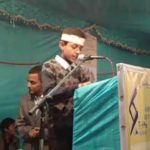Khewra Salt Mine, Pakistan.
Khewra Salt Mine the world’s 2nd largest salt mine, located in Jehlum at distance of 200 kms from Islamabad, the capital city of Pakistan. The mine is a part of a salt range that originated about 800 million years ago, when evaporation of a shallow sea followed by geological movement formed a salt range that stretched for about 300 km.
The Khewra Salt Mine was discovered in 326 B.C, by the horses during the battle between Alexander the Great and Raja Porus at the bank of River Jhelum. The sick horses of Alexander’s army licked the rocks and got well, thereby exposing this enormous treasure of salt deposit at Khewra. Alexander’s army was the first to extract from Khewra Salt Mine.
More than a millenium and a half later after it discovery, in the 13th century, chiefs of Janjua-Raja tribe established commercial mining in Khewra. From 1500s to 1809, Mughals maintained control over the mine and started trading salt to other parts of world including Central Asia. After the downfall of Mughals, Sikhs took the control of the mine in 1809. Punjab was annexed by the British Empire in 1849 and the administration of the mines were taken over by the British Government.
In 1872, modern mining was started by Dr. H. Warth, a British Mining Engineer. He proposed room n pillar method by which only 50% of salt be excavated while the remaining 50% is left as pillars to keep the vast mine from collapsing. 150 years later this same methodology is still being used in Khewra mining operation. To make salt from Khewra mines accessible to rest of Subcontinent, British laid a railway line in 1883 which is operational to date.
Inside this salt mine there is a Mosque (the world’s one and only salt -mosque is made with salt bricks of different colors), and an Asthma Clinic offering salt therapies (yes every structure is made up of salt rock). (Salt caves are seen by some as an alternative to drugs as asthma suffers can benefit from inhaling antibacterial salt particles to clear the lung passages.) Asthma clinic is located deep underground in the mine.
In 2002 the main tunnel was turned into a tourist attraction.The tour of these mines is not only recreational, but also fascinating and educational. It takes only 1½ hour in touring and visiting the various level and buildings of the mines. As soon as one enters the mines, the temperature changes. During hot weather, the mines are naturally found cool, while during winters, the mines feel as if well heated. The stunning beauty, shapes, innumerable colors and shades of red, white and black, and textures of salt found inside the mines, make one wonder. There are a lot of buildings carved in salt stone by the local artists inside the mine.
Courtesy: Pakistan Mineral Development Corporation (PMDC)
Find us on Facebook
Popular Posts
 Sixth Saanjo Anniversary-Ravel Ejaz Speaks
Sixth Saanjo Anniversary-Ravel Ejaz Speaks
January 13, 2018 "Saanjo" First Ever Script of Language of Masses - Punjabi & Allied
"Saanjo" First Ever Script of Language of Masses - Punjabi & Allied
January 13, 2018 Introduction to Saanjo
Introduction to Saanjo
January 13, 2018
Ratings
- Learn Standard Punjabi Language




 (5.00 out of 5)
(5.00 out of 5) - Nadeem Printers, Scheme Moar , Multan Road, Lahore / Billboard Written in Saanjo Script .




 (5.00 out of 5)
(5.00 out of 5) - “Saanjo” First Ever Script of Language of Masses – Punjabi & Allied




 (5.00 out of 5)
(5.00 out of 5) - Punjabi Folk Song




 (5.00 out of 5)
(5.00 out of 5) - Naveed Akram Joins Saanjo Tore-Saanja Dais




 (5.00 out of 5)
(5.00 out of 5) - Khadi pitti ch dikki kholni bhulge || Sharry Maan




 (5.00 out of 5)
(5.00 out of 5) - Visited Baba Najmi Ji /Feb 15 ,2018




 (5.00 out of 5)
(5.00 out of 5) - Maaye ni maaye mere geetan di (Nusrat Fateh Ali Khan)




 (5.00 out of 5)
(5.00 out of 5) - Poetry Gala Islamabad-21 Feb, 2018




 (5.00 out of 5)
(5.00 out of 5) - All out Commitment and Resolve For Saanjo Script-Farhad Iqbal Ji and Ejaz Mahmood




 (5.00 out of 5)
(5.00 out of 5)
- Learn Standard Punjabi Language



 01 Sep 2018
01 Sep 2018
 Posted by admin
Posted by admin 




